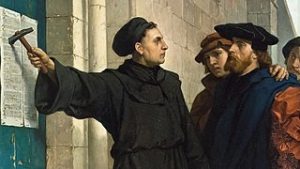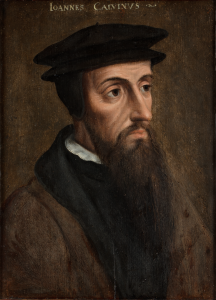Medieval (about 476AD-1600’s)
18 The Protestant Reformation
Ian Mazzola
Introduction
In the heart of 16th-century Europe, a storm was brewing—a tempest of ideas, faith, and defiance that would shake the very foundations of society. It was the age of the Protestant Reformation, a revolution not waged with swords, but with words, pamphlets, and fervent beliefs. Picture the bustling town of Wittenberg, where a solitary Augustinian friar named Martin Luther, hammer in hand, defiantly nailed his Ninety-Five Theses to the doors of All Saints’ Church. Those theses were not just a call for reform within the Catholic Church but a spark that ignited a wildfire of dissent. The Reformation, as it came to be known, was a fervent quest for a faith unburdened by indulgences, one where the Bible, not the Church, would dictate spiritual truths. As Luther’s audacious act reverberated across Europe, others joined the chorus of reform. John Calvin preached predestination in Geneva, Zwingli led a Reformed movement in Zurich, and the Anabaptists defied convention in their quest for a purer Christianity. The Reformation was not just a religious renaissance; it was a catalyst for social change, the proliferation of printing, and the dawn of the Scientific Revolution. The Protestant Reformation was a symphony of dissent that reshaped the course of history, a saga of rebellion against the old order, and the birth of a new world order, one defined by the individual’s quest for truth and the enduring pursuit of faith, knowledge, and freedom.
Connection to STS
The Protestant Reformation played a significant role in promoting free scientific thinking during the 16th century. The movement, sparked by reformers like Martin Luther, Huldrych Zwingli, and John Calvin, emphasized the importance of individual interpretation of religious texts, which extended to broader intellectual pursuits, including science. Additionally, the Reformation’s rapid spread was greatly facilitated by technological innovations, particularly the printing press and the postal system.
It is first important to note how the promotion of scientific thinking was sparked by the Reformation. The translation of the Bible into vernacular languages allowed more people to access and engage with scripture directly. This effort to make religious texts accessible also contributed to increased literacy and access to scientific knowledge. The Reformation’s foundational principle, “sola scriptura” (Scripture alone), encouraged individuals to interpret the Bible independently, which extended to other areas of intellectual inquiry. This emphasis on personal interpretation and conscience paved the way for a more empirical and individualistic approach to understanding the natural world. Furthermore, the Reformation challenged the traditional religious authority of the Catholic Church. As people questioned long-held beliefs and practices, it fostered a culture of critical thinking that extended beyond religious matters. This climate of intellectual inquiry laid the foundation for the Scientific Revolution that followed a few decades later [1].
In addition to the overall pursuit of original thinking, scientific or religious, the invention of the printing press by Johannes Gutenberg in the mid-15th century played a pivotal role in the rapid dissemination of Reformation ideas [2]. The printing press allowed for the mass production of books and pamphlets, making written materials more accessible and affordable. Reformers like Martin Luther and John Calvin utilized this technology to spread their ideas and theological works, fostering greater access to a wide range of knowledge, including scientific literature. The printing press made it possible to distribute texts across large geographical areas, enabling Reformation ideas to reach a broad audience, much broader than any one religious movement up to this point. This rapid and widespread dissemination of information not only promoted religious reform but also eased the exchange of scientific ideas. This was further facilitated by the growing use of the postal system. The establishment and improvement of postal services in Europe facilitated efficient communication between reformers, scholars, and supporters of the Reformation. This network of postal routes allowed for the exchange of written materials and letters, further connecting like-minded individuals across regions. Again, this led to a large and fast spread of both religious and scientific ideas across the entire region.
In summary, the Protestant Reformation’s emphasis on individual interpretation and critical thinking extended to scientific inquiry, promoting free scientific thinking. The movement’s rapid spread was significantly aided by the printing press, which enabled mass production of written materials, and the efficient postal system, which facilitated communication and the dissemination of ideas. These technological innovations not only helped spread Reformation ideas but also laid the groundwork for the Scientific Revolution and many other movements in the future.
Overview and Other Reformers
The Protestant Reformation of the 16th century was a transformative movement that challenged the authority of the Catholic Church, altered the religious landscape of Europe, and had far-reaching effects on society, culture, and religious thought. While Martin Luther is perhaps the most iconic figure of the Reformation, the movement encompassed a diverse array of reformers, some of whose voices are sometimes missing from the Reformation narrative, including Huldrych Zwingli, John Calvin, and Menno Simons, each contributing in their own unique way to the reshaping of Christianity around this time as well.
The Reformation had its ignition point in Wittenberg, Germany, when Martin Luther, a defiant Augustinian friar and professor of theology, posted his Ninety-Five Theses on the door of All Saints’ Church in 1517. Luther’s theses challenged the Church’s practice of selling indulgences, which was a practice that essentially allowed people to pay the church money to reduce their punishment for their sins [3]. The Theses also called for a return to the Bible as the ultimate authority in matters of faith, emphasizing “sola scriptura”.

Martin Luther nailing his 95 Theses to the door of the All Saints’ Church
“Luther 95 Theses” by flickr is in the Public Domain
Luther’s message struck a chord with many who were disillusioned with the Church’s corruption and abuses, and it soon spread like wildfire throughout Europe. The Protestant movement, named after Luther’s “protest” against the Catholic Church, began to take shape.
In Zurich, Switzerland, Huldrych Zwingli led a parallel reform movement that, while sharing some commonalities with Luther’s, also had distinct differences. Zwingli was a priest and humanist scholar who sought to bring about religious change through a careful examination of the Bible. He believed that if a practice or doctrine wasn’t explicitly supported by scripture, it should be rejected. Zwingli’s reformation in Zurich resulted in the removal of many traditional Catholic practices, such as the Mass. Unlike Luther, Zwingli did not advocate for the real presence of Christ in the Eucharist [4], leading to a significant theological division between the Lutheran and Reformed traditions. However, both reformers shared a commitment to sola scriptura, and their movements collectively contributed to the broader Reformation.
Moving to Geneva, Switzerland, we find John Calvin, a highly influential theologian and reformer. Calvin’s ideas formed the foundation of Reformed theology and had a lasting impact on the development of Protestantism. Calvin emphasized the sovereignty of God and the doctrine of predestination, which posited that God had already chosen who would be saved. Calvin’s “Institutes of the Christian Religion” became a seminal work for Reformed theology [5], offering a comprehensive system of Christian belief and practice. His reformed church in Geneva became a model of disciplined, theocratic governance, emphasizing moral and religious conformity. Calvinism spread throughout Europe, particularly in Scotland, the Netherlands, and parts of France. In the latter, it would become known as Huguenotism and played a significant role in the French Wars of Religion.

A portrait of famous reformer John Calvin
“Portrait of John Calvin” by Anonymous is in the Public Domain
In contrast to Luther, Zwingli, and Calvin, Menno Simons was a lesser known yet crucial figure in the Reformation. Menno was an ex-Catholic priest from the Low Countries (modern-day Netherlands and Belgium). He joined the Anabaptist movement, a radical branch of the Reformation that advocated for adult baptism and the complete separation of church and state. The Anabaptists rejected infant baptism and believed that the church should consist of committed, voluntary believers. Menno Simons became a key leader of the Anabaptists and lent his name to the Mennonite tradition, which continues to exist today. His emphasis on nonviolence and the ethics of the Sermon on the Mount became foundational principles for Mennonites.
The Broader Impact of the Reformation
Overall, The Protestant Reformation, while characterized by diverse theological perspectives, shared several key themes: Sola Scriptura, eradication of church abuses, and elevation of individual conscience. The Holy Bible was put forth as the ultimate source of authority in matters of faith, with personal, individual interpretation encouraged. The rejection of practices such as indulgences and a call for greater accountability within the church characterized the movement. And the belief that every individual should have the freedom to pursue their own religious convictions contributed to areas beyond religion as well.
The Reformation had profound societal, cultural, and political consequences. It accelerated the spread of literacy by promoting the translation of the Bible into vernacular languages, allowing people to engage directly with the scriptures. The Reformation also had a significant impact on the emergence of nation-states as rulers saw an opportunity to break free from papal authority and establish state-controlled churches. The Catholic Church’s Counter-Reformation efforts led to internal reforms, ultimately reshaping the institution [6].
Conclusion
The Protestant Reformation stands as a pivotal chapter in history, where the courage of reformers like Martin Luther, Huldrych Zwingli, John Calvin, and Menno Simons reshaped the religious and intellectual landscape. This movement challenged the authority of established institutions, emphasized individual interpretation, and fostered a culture of critical thinking. Beyond theological divisions, it propelled the spread of literacy, the rise of nation-states, and the adoption of transformative technologies like the printing press. The Reformation’s legacy endures, influencing modern religious diversity, the scientific mindset, and the enduring quest for faith, knowledge, and freedom in an ever-evolving world.
Chapter Questions
- What was the name of the church that Luther’s famous 95 Theses were nailed onto?
- What year was the printing press invented?
- Where was John Calvin’s primary reformational influence?
- Name the reformer who is connected with the Mennonite tradition today.
AI Use Disclosure
I used ChatGPT to help me find information about the Protestant Reformation and organize the chapter appropriately.
ChatGPT. (2023). ChatGPT (version 3.5) [Large Language Model]. https://chat.openai.com/
References
-
van Niekerk, F. (2020). Reformation and scientific revolution: Historical coincidence or continual renewal? In Die Skriflig, 54(2). https://doi.org/10.4102/ids.v54i2.2538
-
Zevenson. (2016, December 15). The Printing Press and the Protestant Reformation. History at Normandale. https://historyatnormandale.wordpress.com/2016/12/15/the-printing-press-and-the-protestant-reformation/
-
Schirrmacher, T. (2012). Indulgences: A History of Theology and Reality of Indulgences and Purgatory: A Protestant Evaluation. Verlag Für Kultur Und Wissenschaft.
-
Stephens, W. P. (1994). 10: The Eucharist. In Zwingli: An Introduction to His Thought (pp. 94–110). essay, Oxford Academic.
-
Calvin, J. (1536). Institutes of the Christian Religion. John Calvin.
-
Jirincova, B. (2023, August 11). The Counter-Reformation: How did the Catholic Church Reinvent Itself?. TheCollector. https://www.thecollector.com/counter-reformation /
Images
“Luther 95 Theses” by flickr is in the Public Domain
“Portrait of John Calvin” by Anonymous is in the Public Domain

